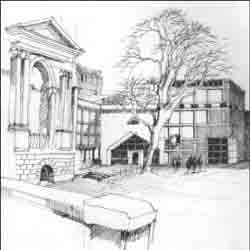FUTURE OF WINCHESTER: A STRATEGIC VISION
The Vision: The `Good City'
In the past cities were seen as the focus of cultural and social values -'Civilisation'.
Aristotle said: Men came together in cities in order to live. They remain together in order to live the good life.
Our challenge is to recapture his vision and build a City that is so good that most people will find it preferable to suburban sprawl.
The Compact City.
Suburbia, being low density, takes up more countryside than we can afford, and causes most journeys to be made by car. This generates traffic that clogs our roads and pollutes the air. However, people want more spacious homes in which to live and work. The answer is to build a compact city of streets and squares giving a higher density, and making walking and cycling more attractive, which, in turn, helps support local shops and services. The `Good City' encourages sustainability and good neighbourliness.
Public spaces are the essential framework.

London, The TateGallery,
Sterling and Wilford
Drawing: Keith Leaman
The `Good City' is much more than the sum of its buildings. Its public spaces - streets, squares, parks - and its public buildings, are the social and cultural arena of the City. They must be designed for their role in public life, and be attractive and friendly places in which people can gather. With increasing density, the design of this essential framework of the City is critical to the success of urban living; it can no longer be left solely to commercial interests, but is a primary responsibility of the City Council.
Streets for people not cars.
If urban living is to be seen as preferable to suburbia it is essential that streets in central and residential areas be designed for people rather than cars. Traffic must give way to pedestrians and cyclists, and must proceed at a walking pace.
Rediscover and revitalise Britain's urban heritage.
Winchester, like most British towns, has happened without much conscious design. However, the Georgians and the Victorians built some fine urban streets and squares, for example, in Bath, Edinburgh, Cheltenham, Harrogate and Brighton. These offer instances of dense city living combined with a generous provision of green space. And in Winchester, we have examples for instance in Eastgate Street, Southgate Street, St Peter Street, St James's Terrace, Clifton Terrace, West End Terrace and Oram's Arbour, and at a smaller scale, St John's Almshouses. Buildings enclosing an inner courtyard with gardens and trees, can achieve high-quality living, and may also be appropriate.
Provide for a broad social and cultural spectrum.
The City derives its dynamic from a diverse mix of people and their activities. Different types of building-use do not have to be un-neighbourly, and should be integrated. We need to encourage an inclusive approach to the provision of lower-cost housing.
Quality is necessary in all aspects.
Quality, which is essential in the `Good City', is not the same as style. Style is a matter of choice and is used to express a personal or public image. Quality of design, architecture, workmanship and materials is identifiable by relationship to established exemplars.
